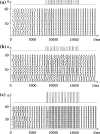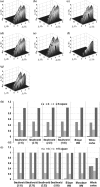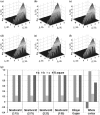A linear model for characterization of synchronization frequencies of neural networks
- PMID: 24465286
- PMCID: PMC3890089
- DOI: 10.1007/s11571-013-9263-z
A linear model for characterization of synchronization frequencies of neural networks
Abstract
The synchronization frequency of neural networks and its dynamics have important roles in deciphering the working mechanisms of the brain. It has been widely recognized that the properties of functional network synchronization and its dynamics are jointly determined by network topology, network connection strength, i.e., the connection strength of different edges in the network, and external input signals, among other factors. However, mathematical and computational characterization of the relationships between network synchronization frequency and these three important factors are still lacking. This paper presents a novel computational simulation framework to quantitatively characterize the relationships between neural network synchronization frequency and network attributes and input signals. Specifically, we constructed a series of neural networks including simulated small-world networks, real functional working memory network derived from functional magnetic resonance imaging, and real large-scale structural brain networks derived from diffusion tensor imaging, and performed synchronization simulations on these networks via the Izhikevich neuron spiking model. Our experiments demonstrate that both of the network synchronization strength and synchronization frequency change according to the combination of input signal frequency and network self-synchronization frequency. In particular, our extensive experiments show that the network synchronization frequency can be represented via a linear combination of the network self-synchronization frequency and the input signal frequency. This finding could be attributed to an intrinsically-preserved principle in different types of neural systems, offering novel insights into the working mechanism of neural systems.
Keywords: Izhikevich model; Neural networks; Neuroimaging; Synchronization frequency.
Figures











Similar articles
-
Characterizing Deep Brain Stimulation effects in computationally efficient neural network models.Nonlinear Biomed Phys. 2011 Apr 15;5(1):2. doi: 10.1186/1753-4631-5-2. Nonlinear Biomed Phys. 2011. PMID: 21496222 Free PMC article.
-
Beta-Rhythm Oscillations and Synchronization Transition in Network Models of Izhikevich Neurons: Effect of Topology and Synaptic Type.Front Comput Neurosci. 2018 Aug 14;12:59. doi: 10.3389/fncom.2018.00059. eCollection 2018. Front Comput Neurosci. 2018. PMID: 30154708 Free PMC article.
-
Spatiotemporal patterns and collective dynamics of bi-layer coupled Izhikevich neural networks with multi-area channels.Math Biosci Eng. 2023 Jan;20(2):3944-3969. doi: 10.3934/mbe.2023184. Epub 2022 Dec 13. Math Biosci Eng. 2023. PMID: 36899611
-
Connection topology dependence of synchronization of neural assemblies on class 1 and 2 excitability.Neural Netw. 2001 Jul-Sep;14(6-7):687-96. doi: 10.1016/s0893-6080(01)00032-6. Neural Netw. 2001. PMID: 11665763 Review.
-
Adaptive rewiring: a general principle for neural network development.Front Netw Physiol. 2024 Oct 29;4:1410092. doi: 10.3389/fnetp.2024.1410092. eCollection 2024. Front Netw Physiol. 2024. PMID: 39534101 Free PMC article. Review.
Cited by
-
Energy dependence on discharge mode of Izhikevich neuron driven by external stimulus under electromagnetic induction.Cogn Neurodyn. 2021 Apr;15(2):265-277. doi: 10.1007/s11571-020-09596-4. Epub 2020 May 11. Cogn Neurodyn. 2021. PMID: 33854644 Free PMC article.
-
Improving the Izhikevich Model Based on Rat Basolateral Amygdala and Hippocampus Neurons, and Recognizing Their Possible Firing Patterns.Basic Clin Neurosci. 2020 Jan-Feb;11(1):79-90. doi: 10.32598/bcn.9.10.435. Epub 2020 Jan 1. Basic Clin Neurosci. 2020. PMID: 32483478 Free PMC article.
References
-
- Bear MF, Connors B, Paradiso M. Neuroscience: exploring the Brain. Philadelphia: Lippincott Williams & Wilkins; 2006.
Grants and funding
LinkOut - more resources
Full Text Sources
Other Literature Sources

